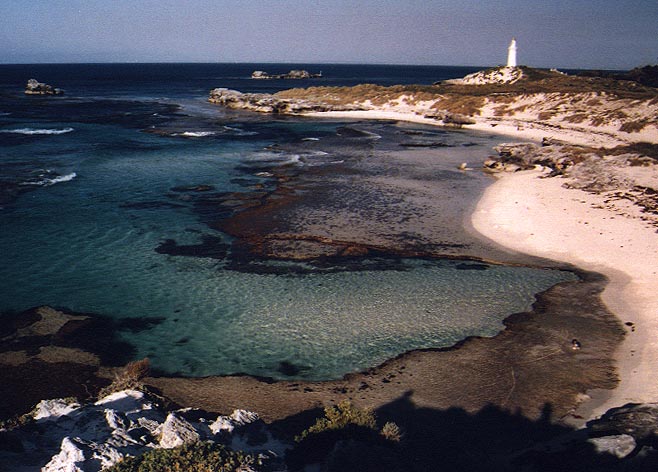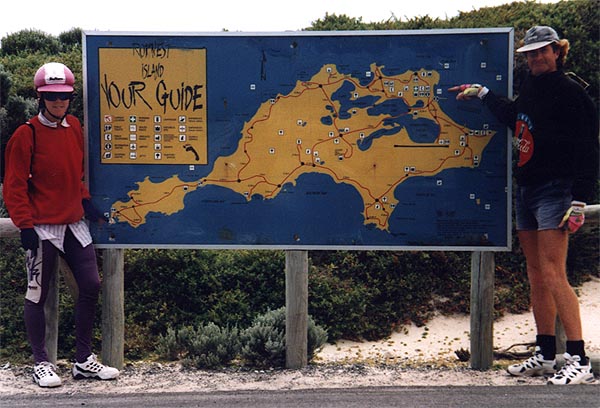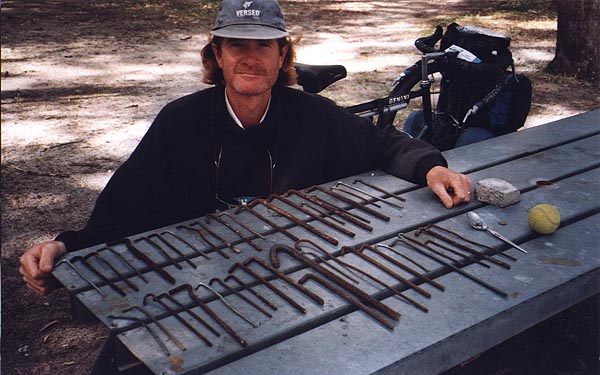|
Karen and I woke at 7am on our last day in Perth to have breakfast and pack the bikes. I oiled both bike chains and pumped up all the tyres before say goodbyes to Trevor, Kate, Zac, Pip and Jessica, plus Captain James Stirling (their dog) and Horatio (their rooster). They had been very good to us, as had Peter and Rhonda, but after a month in Perth it was time to ride again.

Brett, Elle and Mel, Perth and the Swan River
We followed the excellent bike path along the south side of the Swan all the way to Freo, arriving in time for the 9:45am ferry but letting it go without us because of the crowds of people waiting to board and the rush we would have been in to unpack and load our bikes. After a couple of cappuccinos and a cryptic crossword, we prepared for the crossing to Rottnest Island at our leisure, catching the 11:30am ferry instead.
The loading of Elle and Mel was undramatic and the half hour trip to Rotto was the same. At the tourist information centre we paid for three night's camping accommodation and rode a short distance out to the campground for lunch, clocking up a civilised daily total of only twenty one kilometres. After setting up the tent and tying up the bikes, we walked into town for a one hour history tour of the main settlement, for free. Later in the afternoon we did a walk to the Basin on the north side of the island, returning through Geordie Bay and a large area of fenced-off asphalt which formed the catchment area for most of the island's water supply. Just to the west of the settlement we explored a couple of salt lakes, looking for birds and finding plenty. The only new bird we encountered was a resident of an oval near the camping ground - the introduced common pheasant.
We were back at our tent by 6pm for showers and dinner. Just prior to going to bed we discovered a really bad smell coming from Karen's pillow. Sometime during the last month it had developed toxic shock syndrome. Karen slept on a small pile of clothes while the pillow was aired overnight and for most of the next day as well. The pillow, combined with women's troubles, led to a long and disturbed night for Karen, and indirectly for me too.
At 8:15am we took off on our bikes for a circumnavigation of the island. South of town we stopped at Bickley Swamp, where information boards gave us some interesting facts about quokkas, Rottnest Island's small marsupial residents. Because quokkas resemble large rodents, an early Dutch explorer had literally named the island Rat Nest.

Ospreys on their nest
A couple of pages of our bird field guide are devoted to birds known as rails and crakes, which inhabit reeds on the margins of swamps. Karen and I scanned the edge of Bickley Swamp in search of these elusive birds, and thought we had spotted something new. Ever since Jake Loondalup, Karen's mouth had not been working too well, and when she pointed out the alleged new bird, she called it a "rake" - obviously a cross between a rail and a crake. It took both of us about five minutes of close observation and book searching to realise that the "new" birds we had spotted were in fact baby seagulls - we had never seen any before.
During our ride we took various side trips and stopped often. We have already forgotten the detail of these places, but the overall impression of the Rottnest coast is reefs, limestone, crystal clear aqua water and lovely sandy beaches. The island is simply beautiful.

Typical Rotto scene
A short, brisk climb took us up Wadjemup Hill where the lighthouse stands on the island's highest point, a modest forty five metres above sea level. After morning tea in the shelter of a toilet block at Nancy Cove, we crossed a thin connecting strip of land known as Narrow Neck to the western end of the island, where we rode out to Cape Vlamingh, named after the Dutch sailor who named Rottnest. A short walk and a few photos later, we rode back across Narrow Neck with brief looks at Eagle Bay and Mabel Cove, searching for a lunch spot protected from the wind. We found one at Little Parakeet Bay, eating our packed lunches in the shade of a rock overhang on the beach. We were back at our tent by 2:30pm.

Karen and I and a map of Rottnest Island
We were again a bit disappointed to see no new birds, especially at Little Parakeet Bay where we had hoped to see rock Parrots, but we had another two days on the island and still lived in hope. The afternoon and evening was typical of many of the days we spent travelling. Having arrived at our destination, we read in the arvo and walked into town for a dinner of fish and chips. A quick walk to the lighthouse on the north east tip of the island gave us disappointing views of a fading sunset, then it was back into town for a couple of ice-creams. Back at the campground we showered and retired to the relative warmth of the laundry in the amenities block to escape the strong, cool south-westerly winds that had dogged us all day.
Our last full day on Rotto began with a walk into town for a Devonshire Tea deal - two for the price of one - which Karen had spotted. They only had two scones left so they gave us five other pastry things as compensation. It was a lovely way to start the day, warming ourselves in the morning sun at a table by a pool the restaurant's courtyard before setting out for a half-day walk to the salt lakes in search of the elusive rock Parrot.
As soon as we left the restaurant grounds I noticed movement out of the corner of my eye and turned quickly to see a rock Parrot flying overhead. I pointed it out to Karen, but by the time she saw the bird it was only a distant silhouette, so the sighting remained unconfirmed. We did not see another rock Parrot during the rest of the walk, despite constant searching. However, we did see a couple of dugites - Western Australia's most famous deadly snake. One was squished onto the road surface, but the other one was very much alive. It was dark, thin, about a metre long, and we gave it a wide berth as it crossed the road in front of us and climbed the rocky slope of a small cutting.
The highlight of the walk was a visit to a nine point two inch gun emplacement on a hill in the centre of the island. The guns had a range as far as Guildford on the other side of Perth and could therefore protect almost the whole of the city. The views from the hilltop were pretty good too, with the lighthouse not too far away on a neighbouring hill. Closer to the main settlement we climbed yet another hill to a memorial to Vlamingh, which had even better views over the town and the lakes.
In the afternoon we walked down to the jetty to read for a while and to go on a forty five minute semi-submersible two-for-the-price-of-one tour of wrecks, reef and fish a short way off the east side of the island. Having recently snorkelled on the Ningaloo Reef, and having both snorkelled and semi-submersibled on the Great Barrier Reef in the past, Karen and I did not find the tour tremendously exciting, but it was okay. We were glad we had not paid the full price for the trip.
The night began with the usual dinner, reading in the laundry and bed, but became more memorable when Karen found a quokka raiding our muesli in a pannier I had carelessly left undone. A bit later on, another quokka (or maybe the same one) visited the back alcove of our tent and took a lot of persuading to leave. It finally hopped away after lots of pokes and the shining of torchlight into its eyes. As harassment goes, the quokka attack was relatively minor. On the possum scale out of ten, the quokka would only score about two.
With Rotto being so beautiful and so close to Perth, it is visited by lots of city people, many of whom are inexperienced campers. This was made obvious to us by the number of tent pegs I found scattered around the camping area. By the time Karen and I were ready to leave, I had found a diverse collection of forty four tent pegs, none of which we needed. It was common for me to find at least one tent peg at almost every place we camped, but Rotto was a record that would remain unbroken.

My tent peg collection
The return journey to the mainland was just as uneventful as the trip over. Karen and I wrote our impressions of Rottnest Island into the diary. "Rotto is quokkas (filling the ecological niche occupied on the mainland by possums), salt lakes, blue water, limestone bays, bicycles, waders (especially rafts of banded stilts), dugites, history, pheasants, displaying peacocks, and of course tent pegs!" Bikes are the principal form of transport on the island, so a lot of bikes are carried on the ferry every trip. During the unloading of the bikes one of the guys was having trouble lifting Elle and Mel onto the wharf where we were waiting.
"Gees these are heavy!" he said. "Must be round-Australia bikes."
We told him he was right.
|




